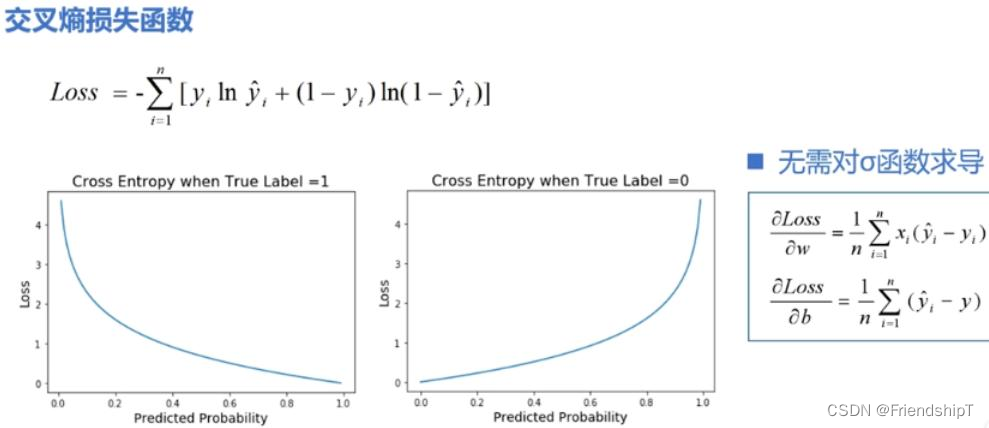YOLO算法中的损失函数:交叉熵和GIOU损失的终极解读
发布时间: 2024-08-14 10:57:14 阅读量: 106 订阅数: 49 


# 1. YOLO算法概述**
YOLO(You Only Look Once)算法是一种单次检测算法,它在计算机视觉领域中用于对象检测。与其他算法不同,YOLO算法只需要一次卷积神经网络(CNN)的前向传播即可检测图像中的所有对象。
YOLO算法的核心思想是将目标检测问题转化为回归问题。具体来说,YOLO算法将图像划分为一个网格,并为每个网格单元预测一个边界框和一个置信度分数。置信度分数表示网格单元中存在对象的概率。如果网格单元中存在对象,则边界框预测该对象的中心点和宽度、高度。
YOLO算法的优点是速度快、精度高。与其他算法相比,YOLO算法可以实时处理图像,同时保持较高的检测精度。因此,YOLO算法广泛应用于视频监控、自动驾驶等领域。
# 2. YOLO算法中的损失函数
### 2.1 交叉熵损失函数
#### 2.1.1 交叉熵损失函数的原理
交叉熵损失函数是一种用于衡量预测概率分布与真实概率分布之间差异的损失函数。它定义为:
```
L_CE = - Σ[y_i * log(p_i)]
```
其中:
* `y_i` 是真实标签,取值为0或1
* `p_i` 是模型预测的概率
交叉熵损失函数值越小,表示预测概率分布与真实概率分布越接近。
#### 2.1.2 交叉熵损失函数在YOLO算法中的应用
在YOLO算法中,交叉熵损失函数用于衡量预测目标类别的概率分布与真实目标类别的概率分布之间的差异。具体而言,对于每个网格单元,YOLO算法会预测该单元包含目标的概率以及目标属于每个类别的概率。交叉熵损失函数计算预测概率分布与真实概率分布之间的差异,并作为YOLO算法的损失函数的一部分。
### 2.2 GIOU损失函数
#### 2.2.1 GIOU损失函数的原理
GIOU(Generalized Intersection over Union)损失函数是一种用于衡量预测边界框与真实边界框之间重叠程度的损失函数。它定义为:
```
L_GIOU = 1 - IoU + (C - A_i) / A_c
```
其中:
* `IoU` 是预测边界框与真实边界框之间的交并比
* `C` 是预测边界框与真实边界框的最小闭包区域
* `A_i` 是预测边界框的面积
* `A_c` 是真实边界框的面积
GIOU损失函数值越小,表示预测边界框与真实边界框之间的重叠程度越高。
#### 2.2.2 GIOU损失函数在YOLO算法中的应用
在YOLO算法中,GIOU损失函数用于衡量预测边界框与真实边界框之间的重叠程度。具体而言,对于每个网格单元,YOLO算法会预测该单元包含目标的概率、目标属于每个类别的概率以及目标的边界框。GIOU损失函数计算预测边界框与真实边界框之间的重叠程度,并作为YOLO算法的损失函数的一部分。
### 表格:交叉熵损失函数和GIOU损失函数的比较
| 特征 | 交叉熵损失函数 | GIOU损失函数 |
|---|---|---|
| 目的 | 衡量预测概率分布与真实概率分布之间的差异 | 衡量预测边界框与真实边界框之间的重叠程度 |
| 优点 | 计算简单 | 能够处理边界框之间的重叠 |
| 缺点 | 无法处理边界框之间的重叠 | 计算复杂 |
### Mermaid流程图:YOLO算法中损失函数的应用
```mermaid
graph LR
subgraph 交叉熵损失函数
A[预测概率分布] --> B[真实概率分布]
B --> C[交叉熵损失值]
end
subgraph GIOU损失函数
A[预测边界框] --> B[真实边界框]
B --> C[最小闭包区域]
C --> D[预测边界框面积]
C --> E[真实边界框面积]
D + E --> F[GIOU损失值]
end
```
# 3. 交叉熵和GIOU损失函数的比较
### 3.1 损失函数的优缺点
**交叉熵损失函数**
* **优点:**
* 计算简单,易于实现。
* 在分类任务中表现良好。
* **缺点:**
* 对于边界框预测不敏感,容易导致边界框预测不准确。
* 对于重叠的边界框,惩罚较轻。
**GIOU损失函数**
* **优点:**
* 考虑了边界框的重叠度,对边界框预测更加敏感。
* 对于重叠的边界框,惩罚较重。
* **缺点:**
* 计算复杂,实现难度较大。
* 在某些情况下,可能会导致边界框预测不稳定。
### 3.2 不同场景下的选择策略
交叉熵损失函数和GIOU损失函数各有优缺点,在不同的场景下,需要根据具体情况选择合适的损失函数。
* **对于分类任务:**交叉熵损失函数是首选,因为它计算简单,易于实现,并且在分类任务中表现良好。
* **对于边界框预测任务:**GIOU损失函数是更好的选择,因为它考虑了边界框的重叠度,对边界框预测更加敏感。
* **对于重叠边界框较多的任务:**GIOU损失函数可以有效地惩罚重叠的边界框,提高边界框预测的准确性。
### 代码示例
以下代码展示了如何使用交叉熵损失函数和GIOU损失函数计算边界框预测的损失:
```python
import torch
import torch.nn as nn
# 交叉熵损失函数
class CrossEntropyLoss(nn.Module):
def __init__(self):
super(CrossEntropyLoss, self).__init__()
self.loss = nn.CrossEntropyLoss()
def forward(self, pred, target):
return self.loss(pred, target)
# GIOU损失函数
class GIOULoss(nn.Module):
def __init__(self):
super(GIOULoss, self).__init__()
def forward(self, pred, target):
# 计算边界框的面积
pred_area = (pred[:, 2] - pred[:, 0]) * (pred[:, 3] - pred[:, 1])
target_area = (target[:, 2] - target[:, 0]) * (target[:, 3] - target[:, 1])
# 计算边界框的交集面积
inter_xmin = torch.max(pred[:, 0], target[:, 0])
inter_ymin = torch.max(pred[:, 1], target[:, 1])
inter_xmax = torch.min(pred[:, 2], target[:, 2])
inter_ymax = torch.min(pred[:, 3], target[:, 3])
inter_area = torch.clamp((inter_xmax - inter_xmin) * (inter_ymax - inter_ymin), min=0)
# 计算边界框的并集面积
union_area = pred_area + target_area - inter_area
# 计算GIOU损失
giou = inter_area / union_area
loss = 1 - giou
return loss
```
# 4. 损失函数在 YOLO 算法中的实践
### 4.1 损失函数的实现
在 YOLO 算法中,损失函数的实现通常涉及以下步骤:
1. **计算预测框和真实框之间的差值:**使用交叉熵损失函数计算分类损失,使用 GIOU 损失函数计算边界框回归损失。
2. **加权求和:**将分类损失和边界框回归损失按一定的权重加权求和,得到总损失。
3. **反向传播:**使用反向传播算法计算损失函数对模型参数的梯度。
4. **更新模型参数:**使用优化器更新模型参数,以最小化损失函数。
### 4.2 损失函数的优化
为了提高 YOLO 算法的性能,可以对损失函数进行优化。常用的优化策略包括:
1. **超参数调整:**调整交叉熵损失函数和 GIOU 损失函数的权重,以平衡分类损失和边界框回归损失。
2. **损失函数加权:**对不同类别的预测框或不同尺度的预测框分配不同的权重,以提高模型对难分类或小目标的检测能力。
3. **正则化:**添加正则化项,如 L1 正则化或 L2 正则化,以防止模型过拟合。
4. **焦距损失:**使用焦距损失函数,以减轻正样本对损失函数的影响,提高模型对难分类样本的检测能力。
### 代码示例
以下代码示例展示了如何使用 PyTorch 实现 YOLO 算法中的损失函数:
```python
import torch
from torch import nn
class YOLOv3Loss(nn.Module):
def __init__(self, num_classes, anchors, lambda_coord=5.0):
super(YOLOv3Loss, self).__init__()
self.num_classes = num_classes
self.anchors = anchors
self.lambda_coord = lambda_coord
def forward(self, predictions, targets):
# 计算分类损失
classification_loss = nn.CrossEntropyLoss()(predictions[:, :, :, :self.num_classes], targets[:, :, :, 4])
# 计算边界框回归损失
regression_loss = self.lambda_coord * nn.MSELoss()(predictions[:, :, :, self.num_classes:], targets[:, :, :, 5:])
# 加权求和
total_loss = classification_loss + regression_loss
return total_loss
```
### 逻辑分析
在上述代码中:
* `__init__` 方法初始化损失函数,包括类别数量、锚框和边界框回归损失的权重。
* `forward` 方法计算总损失,包括分类损失和边界框回归损失。
* 分类损失使用交叉熵损失函数计算。
* 边界框回归损失使用均方误差损失函数计算,并乘以权重 `lambda_coord`。
* 总损失是分类损失和边界框回归损失的加权和。
# 5. YOLO算法的最新进展
### 5.1 YOLOv5中的损失函数改进
YOLOv5对损失函数进行了多项改进,包括:
- **CIOU损失函数:**CIOU损失函数在GIOU损失函数的基础上,增加了中心点距离惩罚项,进一步提高了定位精度。
- **DIoU损失函数:**DIoU损失函数在CIOU损失函数的基础上,增加了方向一致性惩罚项,进一步提高了方向预测精度。
- **复合损失函数:**YOLOv5采用复合损失函数,将交叉熵损失、GIOU损失、CIOU损失和DIoU损失进行加权组合,综合考虑分类、定位和方向预测的误差。
### 5.2 未来损失函数的发展趋势
未来损失函数的发展趋势主要集中在以下几个方面:
- **多目标损失函数:**针对YOLO算法中同时进行目标检测、目标跟踪和目标分割等多项任务,开发能够同时优化多个目标的损失函数。
- **自适应损失函数:**根据不同的训练阶段和数据集特点,动态调整损失函数的权重和参数,以提高训练效率和模型性能。
- **可解释性损失函数:**开发可解释性强的损失函数,以便于分析模型的预测误差来源,并指导模型的优化和改进。
0
0





